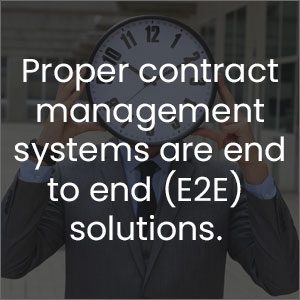For many businesses and professions, 2008 was a watershed year. No doubt it was the worst of times: the world financial system collapsed, triggering the Great Recession. There was the bone-chilling effect on businesses, as many highly esteemed positions disappeared altogether. It also brought fundamental change to the world of in-house counsel, legal operations, and contract management roles.
Enter the era of ‘more for less.’ Instead of viewing every project as a customized ‘snowflake,’ attorneys have started to see the need to fit more engagements in standard roles. The management of contracts is one of the clearest examples of this.
Over the past decade, we have emerged from the ‘wild west’ of software development, reaching the point where proper contract management solutions are taking hold. But it isn’t just about reducing costs and time-consuming elements and creating standard contracts.
WHAT IS PROPER CONTRACT MANAGEMENT?
Proper contract management systems are true end-to-end (E2E) solutions. These systems provide a basis for managing the day-to-day creation and execution of contracts, as well as the analysis of agreements. They are not only effective contract management (CM) technologies but full E2E contract lifecycle management (CLM) technologies. In addition to enabling front-end capability or analytical framework, the intention is to provide robust platforms to support contract administrators. Proper contract management systems are end to end (E2E) solutions.
As pointed out in “CM: More for Less – Is It Possible?”, in today’s world, agreements management software is an utter necessity for businesses. That’s because every mid-large sized organization has thousands of active agreements. We often point out that enterprises can have as many as 20,000 – 40,000 active accords – at any given time – that cannot be managed manually on a spreadsheet. Still, contracts and agreements are the lifeblood of the business world. To keep them flowing efficiently, you need to look for proper contract management options that include:
- Contract repository (single contract system of record | document management)
- Contract authoring (drafting the contract)

- Commitment management and negotiation
- Workflow automation
- Sign-off authorization
- Compliance and governance consistency (terms & conditions) checks
- Risk assessment
- Integrations with Salesforce and electronic signature systems (DocuSign, Adobe…)
- Real-time AI analytics
At this point, it’s all about storing every pertinent information in easily located places. Then, it’s about reducing your risk by first knowing about your standard clauses, terms, and conditions. This is followed by monitoring it all in real-time – to get the pulse of your contracts.
ARTIFICIAL INTELLIGENCE – KEY FEATURE OR FRILL
Simply put, you cannot look into a proper contract management system and not stumble into artificial intelligence (AI) discussion. Many vendors tout their own AI capabilities. But beware! We encountered a few who discussed AI but instead provided outsourced legal workers from developing countries. They ran the ‘HI’ – or human intelligence – analytics. Of course, there’s nothing wrong with this. But when you’re looking for speed across sheer volumes of contracts, HI no longer beats a well-built AI solution. So again: buyer beware. Derek Karpel, in fact, discusses this point in a rather amusing article about making corporate counsel’s life easier.
It’s also important to note that not all AI technologies are built equally well. If this is a ‘hot button’ for you, and you want to have the latest technology at your fingertips, then make these particular search criteria a critical one. Consider whether the AI is developed as an in-house hobby project or built on a well established, industry-leading platform. Try to keep in mind that your reputation, and possibly your career, could be judged on making the right call on this new tech. As a result, look for vendors that have built their AI on solid platforms like IBM Watson.
When it comes to proper contract management deployment, one should also consider whether the system includes AI throughout the solution. Gartner, in this regard, highlighted ContractPodAi as the only system on the market that embeds AI technology throughout the application. Rather than leveraging it exclusively at the front end, or in the analytics engine, the system uses AI technology everywhere. Gartner described ContractPodAi as a ‘Cool Vendor’ for exactly this reason.
CONTRACT AGNOSTIC – A RELIGIOUS DEBATE?
Occasionally, we still hear certain vendors promoting the idea that clients need either a specific buy-side or sell-side solution. These are fanciful notions best left in the past. Today’s businesses need to be agreement agnostic. Think about it for a moment. Your organization might have a procurement group (buy-side) and a sales team (sell-side). And these two are clear users of agreements – those that would benefit from a respectable CLM. But beyond that, you also have NDA’s, intellectual property accords, partnership agreements, HR-employee contracts, memos of understanding (MOUs), service level agreements (SLA) between groups, and so on.
Ultimately, you need systems that can support all types of contracts, not just one group or another. Make sure to receive the broad opinion of your internal key stakeholders, not to mention the users on your vendor choices. At the end of the day, the stakeholders will be the ones using the system. And the last thing that you want is a group of disgruntled users grumbling every time that they have to log into the CLM.
PROPER CONTRACT MANAGEMENT: DEEPER INVOLVEMENT
It isn’t just for contract managers and the office of the general counsel anymore! A full, proper contract management system is one that the entire organization can use. Naturally, not every function will need access. Nor will everyone in the company need the same level of access to the system. Nevertheless, today’s technology means that your sales teams – the groups responsible for your business relationships – and standard teams, like legal operations and procurement, require access.
Yes, it’s rather simple to make the statement that everyone needs access to your CLM. But after doing a little successful dance – and singing Kumbaya – we come back to our senses. Regarding the life cycle of an agreement, you should ask how you engage the ‘deeper involvement’ of the various fractions in the organization? More importantly, how do you make this a long-term effort? And better yet, how do you pull this off without spending an inordinate amount of time training, retraining, and endlessly teaching people how to get into the system to ‘do things?’
INTUITIVE UI = PROPER CONTRACT MANAGEMENT
A proper contract management solution supports you with the right features and capabilities. The ugly truth is that it’s all about elegance, simplicity, and – yes – beauty!
During a five-week field journey through trade shows across Europe and North America, we spoke with a few contracting professionals. Unsurprisingly, we talked about the importance of cloud-based technologies in this realm. No proper contract management project should be discussed without considering a Microsoft Azure cloud technology, for example. But beyond that, one of the most important resonating themes I heard from customers was the importance of having an intuitive interface. Generally speaking, these discussions came from either a glimpse at our demo or from a prospect complaining about how much they hate their current competitor’s system.
Although I was delighted to hear these comments, they highlighted an important point. A proper contract management solution must support you with the right features and capabilities. Yet it must also provide an exceptionally easy user interface. With the deeper engagement of CLM technologies by the broader organization, you cannot expect every user to develop the expertise of a daily practitioner. So it has to be attractive, engaging, and simple to use. Otherwise, you’ll be inundated with calls and emails asking for a quick reminder on ‘how to do this one little thing’ in the solution. That doesn’t sound that bad until you find yourself spending hours repeating the same mini-training sessions over and over.
The key lesson here is that when you’re looking for your system, remember that a proper contract management solution must include an amazing user interface. This part isn’t a frill. It should be a core necessity!
HELPING GUIDE
Much of the discussion above is about seeking and finding proper contract management solutions. Not just those that will barely do the job. If you’re interested in a deeper review of agreements management, read our contract management primer. It provides a short update on the key parts of this important subject. It also shows a conservative ROI on the results that you can expect from a better system. What’s more, it includes a very handy checklist, which can be used while assessing different vendor capabilities.
The guide is completely free! Do yourself a favor and download it today.
Author:

Sarvarth Misra
Connect with us on Linkedin
Further Reading:
- Enterprise Contract Management
- Tips for Enterprise Contract Management
- SaaS in Legal Technology: What Are My Options?


